Indianapolis International Airport (IND) is enjoying the benefits of rehabilitating Runway 14-32, its main crosswind runway that also happened to be one of its oldest. Associated connector taxiways were upgraded with new pavement and lighting as well.
Indianapolis International Airport (IND) is enjoying the benefits of rehabilitating Runway 14-32, its main crosswind runway that also happened to be one of its oldest. Associated connector taxiways were upgraded with new pavement and lighting as well.

FAA picked up 71% of the tab for the $23.5 million project, and the airport’s capital improvement budget paid for the other 29%. Officials at IND saw the pavement rehabilitation as a prime opportunity to make other improvements at the same time—specifically, new approach lights at both ends of the crosswind runway.
“We approached the FAA with this suggestion, and they gave us funds for that as well,” says Tony McMichael, director of Airside Development. “This worked out nicely, because we will not have to close down Runway 14-32 again in the foreseeable future. In our opinion, this was a big win.”
When the expenses were tabulated, the entire initiative came in slightly under budget. Of equal importance, the runway was ready on time for the busy holiday travel season.
|
Project: Runway Rehabilitation Location: Indianapolis Int’l Airport (IND) Runway: 14-32 Length: 7,200 ft. Budget: $23.5 million Funding: 71% FAA; 29% airport capital improvement budget Timeline: Engineer selected Dec. 2017; plans presented to FAA June 2018; grant application approved late 2018; construction May 2019 to Dec. 2020 Engineering & Design: Hanson Professional Services Construction: Milestone Contractors Concrete Rubblization Subcontractor: Antigo Construction Airfield Electrical & NAVAID Design: CHA Consulting Electrical Subcontractor: Hoosier Lights & Signs: ADB SAFEGATE Geotechnical Engineering: Terracon Topographic Survey & Data Collection: Align Civil Engineering Consultants Constructability Review: B&R Consulting Key Benefits: New runway surface for commercial & general aviation aircraft; new approach lights at both ends of runway; pavement & lighting improvements for connector taxiways |
Jarod Klaas, senior director of Planning and Development at the airport, notes that it took careful timing and collaboration to make the ambitious project a success.
“This runway dates back several decades,” says Klaas. “It is the main crosswind runway here at IND, stretching 7,200 feet, and is used frequently by both general aviation and corporate aircraft.“
As a main airfield artery, Runway 14-32 needed to be in good condition. “This runway was last rehabilitated in 2001, and was nearing the end of its useful life,” explains Keith Berlen, senior director of Operations, Public Safety and Parking. “We had been fixing it up in a patchwork manner for the last few years, and we concluded that it just was time to rehabilitate it, and to redo its connector taxiways as well.”
To design and implement the project as efficiently as possible, IND hired Hanson Professional Services as the main engineering consulting firm, with its subcontractor CHA leading the electrical design.
Hanson’s responsibilities included the initial design work, helping create the bid packages for various contractors, and overseeing the construction itself. Joe Worley, the firm’s senior project manager, recalls that the design team faced tight deadlines from the very start. “After being awarded the project [in December 2017], we had to present final plans to the FAA by June 2018, as part of the application process to get the federal grant needed,”
Worley recalls.
With no time to spare, Hanson evaluated various pavement structures by performing visual inspections, researching historical analysis and record drawings, taking pavement cores and soil borings, and completing an extensive geotechnical evaluation. The firm also developed phasing plans to minimize the impact of construction on airport operations.
Worley notes that special considerations for the project included understanding and evaluating the varied age and material structure of the runway and taxiway pavements, implementing new FAA taxiway connector design standards, minimizing impact on high profile “front door” tenants and optimizing and modernizing airfield electrical improvements.
 The expedited effort to prepare the design plans paid off. The FAA approved IND’s grant application in late 2018, which allowed Hanson and airport officials to solicit bids from potential contractors. Milestone secured the role of lead contractor and subcontracted Hoosier for the electrical work.
The expedited effort to prepare the design plans paid off. The FAA approved IND’s grant application in late 2018, which allowed Hanson and airport officials to solicit bids from potential contractors. Milestone secured the role of lead contractor and subcontracted Hoosier for the electrical work.
Before construction started in May 2019, the biggest challenge was to make sure that all pavement strengths would be consistent and FAA-compliant, for both the runway and its connectors. “When we did our original analysis of all the pavements, it was readily obvious that the runway and its connectors all had different types of pavement structure,” Worley explains. “We emphasized to the contractor that we needed FAA-approved material standards and that everything had to be consistent.”
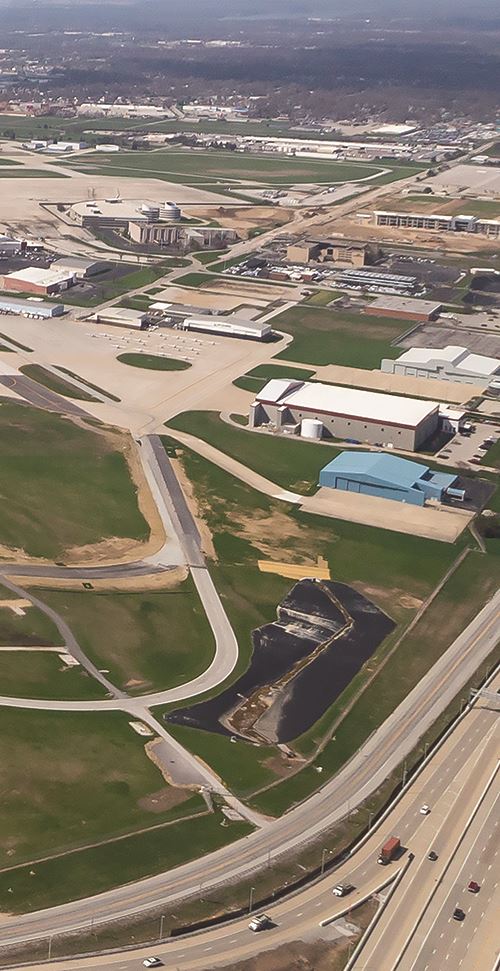
The 3 Cs
With Runway 14-32 needing to close for several months during construction, Berlen and other operations personnel emphasized the need to accommodate airport stakeholders. “We met with all of our tenants, and kept most taxiways open,” he relates. “We understood that we needed to maintain access for them. Not all taxiways stayed open, but there were enough so planes could get to main runways to take off and land. Air traffic control and airlines had access to alternative runways and taxiways all the time.”

Work was scheduled and executed in several phases to minimize disruption on the airfield. McMichael notes that the strategy of closing various taxiways during different periods required continual communication with stakeholders.
“With all projects that we do, we follow the three Cs: communication, coordination and collaboration,” states McMichael. “This also included design review meetings and safety risk assessments. We had in-person weekly meetings for anyone who wanted to attend. We also distributed weekly emails to all of our clients, and shared what phases and milestones were achieved. This included the minutes of each meeting. During construction, we had weekly coordination with the FAA and other folks.”
The project team also focused on keeping the airport’s emergency service providers abreast as construction progressed. “It was vital that the fire and police departments knew which taxiways were open, so they could respond to an emergency situation on the airfield as quickly as possible,” says Berlen. “We made sure they knew where to go as we moved from one phase to another.”

Pavement Issues
One of the biggest challenges was that Runway 14-32 had different types of pavement structures installed at different times. The original runway was concrete, but various layers of asphalt overlays had been applied in various sections throughout the years. “The geotech analysis we did before construction found a lot of irregularities,” McMichael reports. “We wanted to make both the runways and taxiways a consistent strength and surface, and we made sure we met FAA specifications on pavement surfaces throughout the project.”
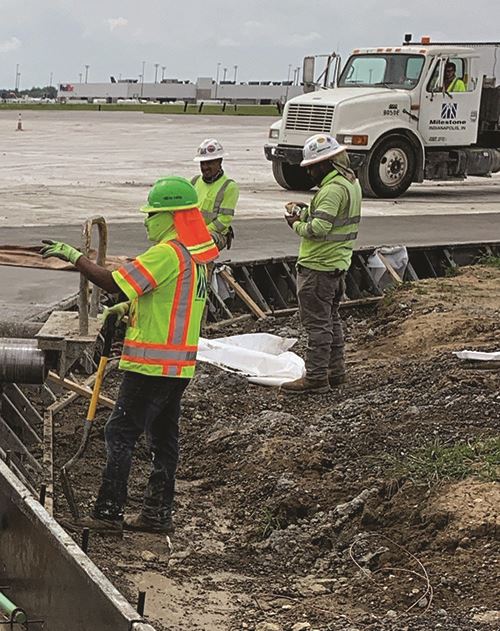
The Construction Safety Phasing Plan divided the project into several phases, with contractors starting on the north/14 end. Part of the work consisted of enlarging the blast pad to current FAA requirements, which required excavation and installing additional pavement. Completing the blast pad work took longer than expected because the Indianapolis area had a rainy spring in 2019. However, the airport worked with Milestone to preserve the overall schedule.
For instance, when the contractor added extra shifts to make up time, care was taken to ensure that the lights needed for nighttime construction did not adversely affect airport operations.
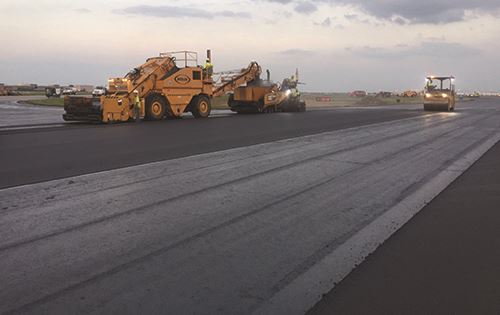
Electrical work performed on the runway and adjoining taxiways also presented challenges. “In the past, all electrical circuits had been done piecemeal,” says Worley. “During construction, the contractors occasionally found old cables. They were not sure if they were live or not, or what they were used for. Fortunately, most of them were abandoned and not energized.
 “We have now created a much safer environment,” he adds. “We have a user-friendly map showing the wiring of all electrical systems and LED lights, and it shows which cables connect to which lights.”
“We have now created a much safer environment,” he adds. “We have a user-friendly map showing the wiring of all electrical systems and LED lights, and it shows which cables connect to which lights.”
The rehabilitation of the runway and its connector taxiways earned praise from many stakeholders. “This was a successful project from beginning to end,” Klaas summarizes. “I think we had excellent teamwork from all parties involved to accomplish this on schedule and on budget.”
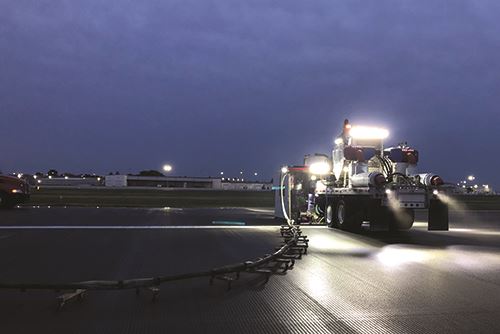
During the final stage of construction, crews paved the runway and taxiways with the same mixture to create consistent surfaces.

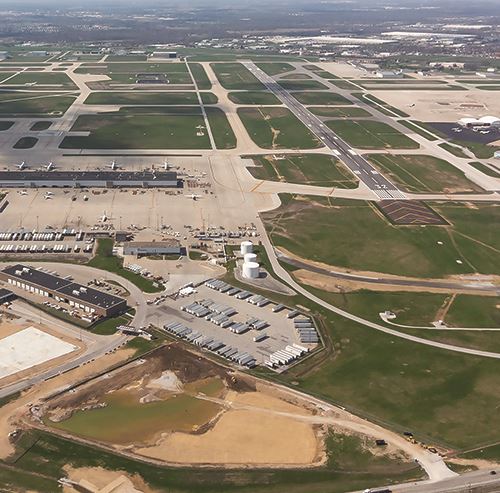
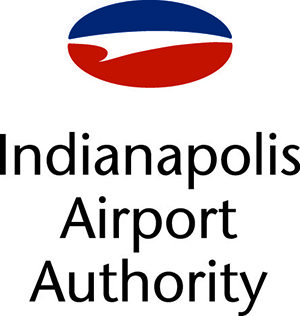 facts&figures
facts&figures

